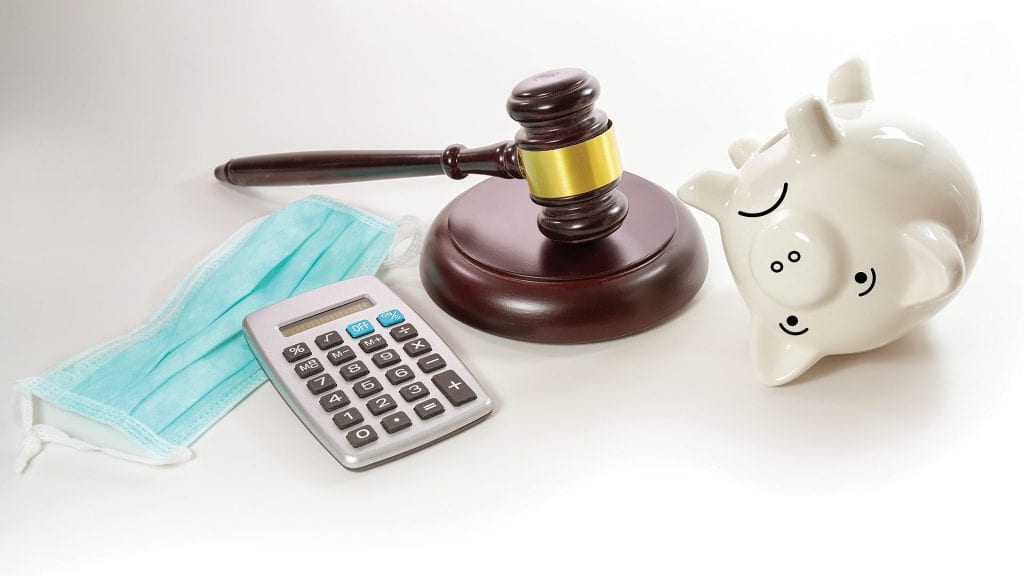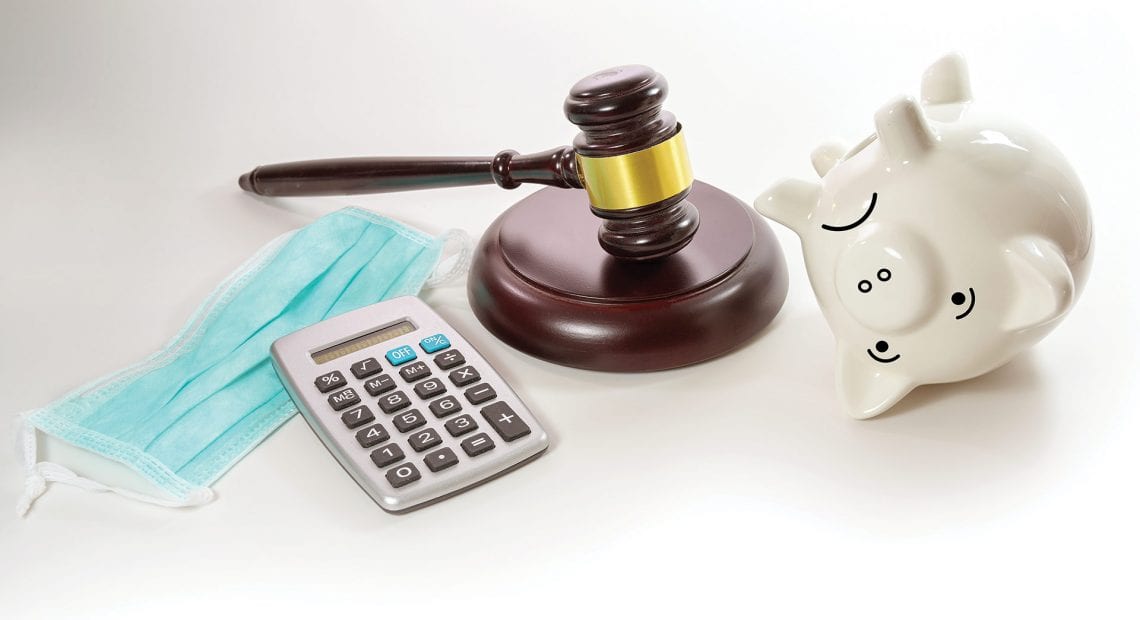Risky Business
By Amy B. Royal, Esq.
 The pandemic has already created a flurry of individual and class-action lawsuits against companies. In fact, according to data collected through a national association for lawyers, it is estimated that approximately 80 COVID-related litigation cases have been filed in Massachusetts alone, and more than 5,000 across the country. These cases are expected to be very costly to defend.
The pandemic has already created a flurry of individual and class-action lawsuits against companies. In fact, according to data collected through a national association for lawyers, it is estimated that approximately 80 COVID-related litigation cases have been filed in Massachusetts alone, and more than 5,000 across the country. These cases are expected to be very costly to defend.
The most common types of cases that have emerged involve health and safety violations, discrimination, and leaves of absence from work. In understanding the trends of lawsuits that have already been filed, businesses can better prepare by assessing risk and perhaps mitigate their exposure to liability in the process.
The Safety Suits
Not surprisingly, several COVID-related lawsuits involve health and safety claims. The common theme among them is that a company failed to provide a safe environment either for their employees or for their customers. Some of the lawsuits allege a failure-to-warn component, i.e., that the company knew an individual had exhibited COVID-19 symptoms at the place of business, yet the company failed to inform employees and customers. Other lawsuits involve claims that companies either did not provide adequate PPE or otherwise take necessary precautions to protect people.

Amy B. Royal, Esq
An offshoot of the safety suits involve whistleblower claims under OSHA, a federal law that addresses standards for workplace health and safety. Employees can blow the whistle on their employer by reporting potential workplace health and safety issues to (and filing complaints with) the Occupational Safety and Health Administration, a division of the Department of Labor.
“According to data collected through a national association for lawyers, it is estimated that approximately 80 COVID-related litigation cases have been filed in Massachusetts alone, and more than 5,000 across the country.”
Many of the COVID-related OSHA claims are for retaliation. Specifically, several employees have filed complaints alleging they suffered an adverse employment action after notifying their employer of violations of social-distancing guidelines or failures to maintain proper cleaning of workspaces or PPE.
Discrimination
Age, disability, and pregnancy discrimination cases related to COVID-19 have been on the rise since the summer months. These types of cases typically arise under the following general set of circumstances: the employee refuses to return to the physical workspace citing their age, disability, or pregnancy as too much of a risk factor, and their employer terminates them or, in the context of disability and pregnancy, does not accommodate them by allowing them to work at home.
However, these same types of discrimination cases arise in a different way as well, underscoring the fact that no good deed goes unpunished. Believe it or not, good-intentioned employers that have told their older workers or those with known pre-existing conditions to work from home, take a leave of absence, or accept a furlough while bringing back their younger or non-disabled counterparts are getting smacked with age and disability discrimination claims.
Although these employers may have been acting out of concern for their workers that they perceived as high-risk, preventing them from returning to the workplace can give rise to a potentially viable age or disability discrimination claim. Indeed, the Equal Employment Opportunity Commission (EEOC), our federal enforcement agency for discrimination claims, issued guidance on this specific situation. In a nutshell, the EEOC has taken the position that employers cannot do this unless they can show their employee’s physical presence in the workplace poses a “direct threat,” which is an extremely high standard to meet.
The Families First Coronavirus Response Act (FFCRA)
The FFCRA came into effect in what felt like a nanosecond and, thus, created a quagmire. Businesses suddenly needed to understand the act, implement it, and comply with it.
The act, which included the Emergency Paid Sick Leave Act and the Emergency Family and Medical Leave Expansion Act within it, requires covered employers to provide employees with paid sick leave or expanded family and medical leave for certain qualifying reasons. The act took effect in April and presently is slated to remain in effect through the end of the year. It applies to employers with fewer than 500 employees.
“Some of the lawsuits allege a failure-to-warn component, i.e., that the company knew an individual had exhibited COVID-19 symptoms at the place of business, yet the company failed to inform employees and customers.”
Now that the act has been in effect for just over six months, lawsuits under it have begun to emerge. The majority of these lawsuits involve the caregiver provisions of the act.
The act mandates that employers provide 80 hours of paid sick leave to employees to care for:
• An individual who is subject to a governmental quarantine or isolation order or is advised by a healthcare provider to self-quarantine due to COVID concerns; or
• Their child if the child’s school or daycare is closed or the childcare provider is unavailable due to the pandemic.
Further, the Emergency Family Medical Leave Act portion of the FFCRA permits employees to take 12 weeks of job-protected leave to care for their child if the child’s school or daycare is closed or the childcare provider is unavailable.
In these FFCRA lawsuits, employees are claiming either that their requests for leave were improperly denied or that they were retaliated against for availing themselves of their rights under the act.
The ‘Take Home’ Cases
The ‘take home’ cases are the scariest of them all as they carry the biggest monetary exposure to businesses. The crux of them is this: an employee contracts COVID-19 at his or her workplace. A family member becomes infected and becomes very ill or tragically dies. A claim is then brought by the family member against the employer for negligence under the theory that the employer failed to warn or failed to take reasonable precautions.
Workers’ compensation laws are generally the exclusive remedy to employees for workplace injuries. This means employees cannot bring negligence claims against their employer for workplace injuries. The reason for the workers’ compensation system was to limit employers’ exposure to large, multi-million-dollar damage awards in personal-injury cases, as workers’ compensation laws impose caps on damages. Take-home cases, however, are not capped and could potentially generate a nuclear verdict.
There is precedent for take-home cases in the asbestos litigation space. Indeed, family members have received landslide settlements and verdicts from many companies claiming they developed mesothelioma after their spouse, for example, brought asbestos into their home after work.
The first take-home COVID-19 case was recently filed in Illinois by a daughter who alleged her mother died after her father contracted coronavirus at work and then brought it back into the home, infecting her mother. In this wrongful-death lawsuit, the daughter alleges her father’s employer should be on the hook for the exposure to her mother that her father ‘took home’ to her, which ultimately caused her mother’s death. Other take-home cases have begun to emerge around the country as well.
What Can Be Done to Mitigate Risk?
Two words: comprehensive planning. Proper planning includes knowing what laws apply to your company, assessing them and assessing your overall areas of risk, taking proactive steps, and designating a team to help create, implement, manage, and adapt to COVID-related issues. Then, put pen to paper and document your efforts.
Amy B. Royal, Esq. is a litigation attorney who specializes in labor and employment-law matters at the Royal Law Firm LLP, a woman-owned, women-managed corporate law firm that is certified as a women’s business enterprise with the Massachusetts Supplier Diversity Office, the National Assoc. of Minority and Women Owned Law Firms, and the Women’s Business Enterprise National Council; (413) 586-2288; [email protected]





